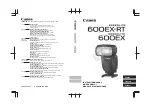
IMPORTANT
•
Select “Not use” when operating without an SD memory card.
•
Before removing the SD memory card from the camera, it is necessary to select “Not use” first. The
recorded data may be corrupted if the SD memory card is removed when “Use” is selected.
•
When an SD memory card is inserted when “Use” is selected, data will be saved in accordance with
the setting of “Save trigger”.
•
After inserting the SD memory card, it is necessary to select “Use” to use the SD memory card.
•
When playing or downloading images saved on the SD memory card, it is necessary to select “On” for
“Save logs” on the [Log] tab (
®
page 79) in advance.
•
When the image refresh interval is short, notification/recording timing or interval may become incorrect.
Notification/recording may also not be performed correctly as configured when multiple users are
receiving images. In this case, set the refresh interval longer.
•
There are limited times to overwrite on an SD memory card. When having a high frequency of
overwriting, the lifetime of the SD memory card may become shorter.
•
A lifetime of an SD memory card should be influenced by the number of the image files stored and log
savings on the SD memory card. Selecting “H.264(1)” or “H.264(2)” for “Recording format” can reduce
the number of files to be stored on the SD memory card.
•
If the data writing speed goes down after data is repeatedly written on an SD memory card, we
recommend replacing the SD memory card.
[Recording format]
Select “JPEG”/“H.264(1)”/“H.264(2)” for the video encoding format of image data to be recorded on the SD
memory card.
•
JPEG:
Records still image data.
•
H.264(1):
Records video data (H.264(1)) in the MP4 video encoding format. Audio will not be recorded.
•
H.264(2):
Records video data (H.264(2)) in the MP4 video encoding format. Audio will not be recorded.
•
Default:
JPEG
Note
•
When “H.264(1)” is selected, it will become impossible to transmit images with the settings of H.
264(1). When “H.264(2)” is selected, it will become impossible to transmit images with the settings of
H.264(2).
•
When “H.264(1)” is selected, the settings for “H.264(1)” on the [JPEG/H.264] tab of the “Image/
Audio” page will be changed to the settings for “H.264 recording”.
When “H.264(2)” is selected, the settings for “H.264(2)” on the [JPEG/H.264] tab of the “Image/
Audio” page will be changed to the settings for “H.264 recording”.
•
When “H.264(1)” is selected, the priority band may not be maintained if “H.264(1)” for “Priority
stream” - “Stream type” on the [System] tab of the “User mng.” page.
When “H.264(2)” is selected, the priority band may not be maintained if “H.264(2)” for “Priority
stream” - “Stream type” on the [System] tab of the “User mng.” page.
•
When the “Image capture mode” type is 3M Fisheye (Max. 15 fps), the “H.264(2)” is unavailable.
•
When the “Image capture mode” type is 2 Monitor (Max. 15 fps), “H.264(1)” displays the Panorama
image or Double Panorama image, and “H.264(2)” displays the Quad PTZ image or Single PTZ image.
“JPEG” displays the image configured for “"Live" page (Initial display)”.
•
When using the SD memory recording function of a Panasonic network disk recorder, select “JPEG”
for “Recording format”.
•
When the setting of “Recording format” is changed between “JPEG” and “H.264(1)” or “H.264(2)”,
format the SD memory card. (
®
page 68)
•
Due to the difference in file formats, the indication of remaining capacity of the SD memory card differs
between the cases when “JPEG” is selected and when “H.264(1)” or “H.264(2)” is selected for
“Recording format”.
•
When “H.264(1)” or “H.264(2)” is selected for “Recording format”, the following settings in “H.264
recording”; Image capture size, Frame rate, Max bit rate, Image quality, and Refresh interval will be
62
Operating Instructions
10 Configure the basic settings of the camera [Basic]
Содержание WV-SF430 Series
Страница 178: ...5 Click Finish 178 Operating Instructions 17 Configuring the network settings Network ...
Страница 222: ...222 Operating Instructions Notes ...
Страница 223: ...Operating Instructions 223 Notes ...
















































